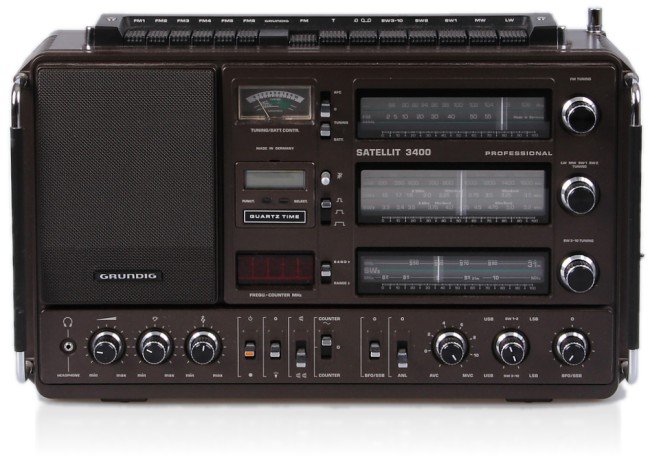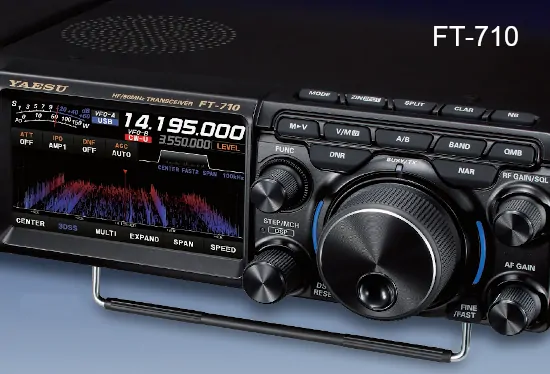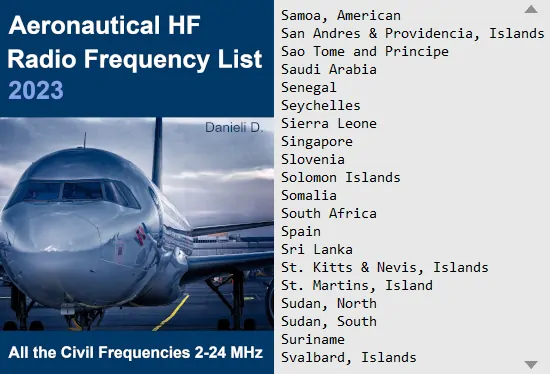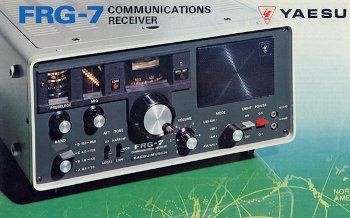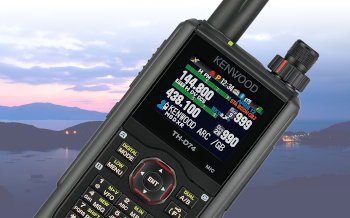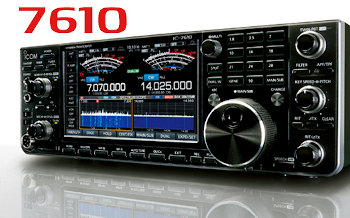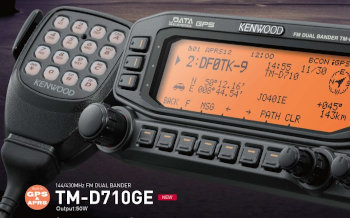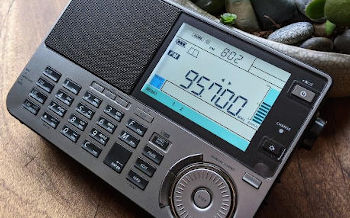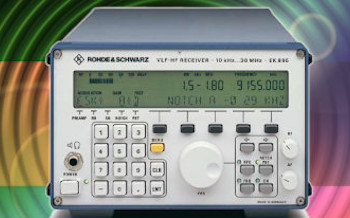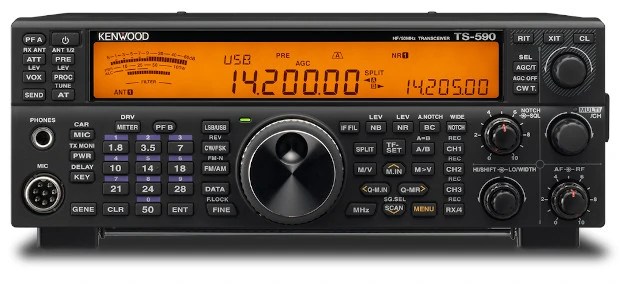
Easy to operate HF/50MHz transceiver with high dynamic range and double / triple superheterodyne circuit. Equipped with 500 Hz and 2.7 kHz roofing filter as standard, CW Morse code decoder. Offers 100W of output power, built-in antenna tuner. Ideated in Japan, year of introduction 2014.
Reference market : amateur-radio
TS-590SG specifications
| General |
| Frequency coverage | |
|---|---|
| Receive | 0.0300 ~ 60.0000 MHz [1] |
| Transmit [2] | 0.1370 MHz band [3] 1.8000 ~ 2.0000 MHz 3.5000 ~ 4.0000 MHz 5.2500 ~ 5.4500 MHz 7.0000 ~ 7.3000 MHz 10.1000 ~ 10.1500 MHz 14.0000 ~ 14.3500 MHz 18.0680 ~ 18.1680 MHz 21.0000 ~ 21.4500 MHz 24.8900 ~ 24.9900 MHz 28.0000 ~ 29.7000 MHz 50.0000 ~ 54.0000 MHz |
| Mode | |
| CW / PSK / FSK (RTTY) / LSB / USB / AM / FM | |
| Tuning step | |
| 1 / 10 / 100 / 500 Hz / 1 / 2.5 / 5 / 6.25 / 9 / 10 / 12.5 / 15 / 20 / 25 / 30 / 50 / 100 / 500 KHz / 1 MHz | |
| Receiver |
| Sensitivity | |
|---|---|
| CW / SSB | 0.5 uV (0.13~0.522 MHz, 10dB S/N) 4.0 uV (0.522~1.705 MHz, 10dB S/N) 0.2 uV (1.705~24.5 MHz, 10dB S/N) 0.13 uV (24.5~30 MHz, 10dB S/N) 0.13 uV (50~54 MHz, 10dB S/N) |
| PSK / FSK | 0.5 uV (0.13~0.522 MHz, 10dB S/N) 4.0 uV (0.522~1.705 MHz, 10dB S/N) 0.2 uV (1.705~24.5 MHz, 10dB S/N) 0.13 uV (24.5~30 MHz, 10dB S/N) 0.13 uV (50~54 MHz, 10dB S/N) |
| AM | 6.3 uV (0.13~0.522 MHz, 10dB S/N) 31.6 uV (0.522~1.705 MHz, 10dB S/N) 2.0 uV (1.705~24.5 MHz) 1.3 uV (24.5~30 MHz, 10dB S/N) 1.3 uV (50~54 MHz, 10dB S/N) |
| FM | 0.22 uV (28~30 MHz, 12 dB SINAD) 0.22 uV (50~54 MHz, 12 dB SINAD) |
| Selectivity [4] | |
| CW | > 0.5 KHz (-6dB)
< 1.2 KHz (-60dB) |
| FSK | > 0.5 KHz (-6dB)
< 1.2 KHz (-60dB) |
| SSB | > 2.2 KHz (-6dB)
< 4.4 KHz (-60dB) |
| AM | > 6.0 KHz (-6dB)
< 12.0 KHz (-50dB) |
| FM | > 12.0 KHz (-6dB)
< 25.0 KHz (-50dB) |
| RF preamplifier | |
| Yes | |
| RF attenuator | |
| Yes | |
| DR (Dynamic Range) [5] | |
| 87 dB (2 KHz spaced signals, 7 MHz, BW 500 Hz, Pre OFF, RX1) 107 dB (20 KHz spaced signals, 7 MHz, BW 500 Hz, Pre OFF, RX1) |
|
| RMDR (Reciprocal Mixing Dynamic Range) [5] | |
| 99 dB (2 KHz spaced signals, 7 MHz, BW 500 Hz, Pre OFF, RX1) 110 dB (5 KHz spaced signals, 7 MHz, BW 500 Hz, Pre OFF, RX1) 122 dB (20 KHz spaced signals, 7 MHz, BW 500 Hz, Pre OFF, RX1) |
|
| Synthesizer phase noise | |
| -110 dB typ (14.2 MHz, offset 1 KHz) -145 dB typ (14.2 MHz, offset 20 KHz) |
|
| Spurious and Image rejection | |
| > 70 dB (HF bands) | |
| IF rejection | |
| > 70 dB | |
| Notch filter | |
| Manual | > 70 dB Width selectable on Normal / Wide |
| Automatic | > 60 dB Mode selectable on continuous / intermittent beat signals |
| NB (Noise Blanker) | |
| Mode selectable NB1 / NB2 | |
| DNR (Digital Noise Reduction) | |
| Mode selectable NR1 / NR2 | |
| RIT (Receiver Incremental Tuning) | |
| ± 9.999KHz | |
| AGC (Automatic Gain Control) | |
| low, fast, off. Adjustable time constant | |
| Frequency stability | |
| ± 5 ppm max with temperature from -10°C to +50°C ± 0.5 ppm max with temperature from -10°C to +50°C [6] |
|
| IF (Intermediate Frequency) | |
| 1° | 11.374 MHz [7] 73.095 MHz [8] |
| 2° | 24 kHz [7] 10.695 MHz [8] |
| 3° | 455 kHz (FM) [8] 24 kHz (except FM) [8] |
| IF roofing filter [7] | |
| 0.5 / 2.7 KHz | |
| Squelch sensitivity | |
| SSB / CW / FSK / AM | < 5.6 uV (threshold, 0.13~0.522 MHz) < 18 uV (threshold, 0.522~1.705 MHz) < 1.8 uV (threshold, 1.705~30 MHz) < 1.1 uV (threshold, 50~54 MHz) |
| FM | < 0.2 uV (threshold, 28~30 MHz) < 0.2 uV (threshold, 50~54 MHz) |
| CW features | |
| Morse code decoder CW auto-tune CW reverse mode Semi break-in (delay time 50-1000ms) / full break-in Pitch control (300~1000Hz in 50 Hz steps) |
|
| Transmitter |
| Output power | |
|---|---|
| CW / RTTY / SSB / FM | 5 ~ 100 W |
| AM | 5 ~ 25 W |
| Spurious emission | |
| < -50 dB (1.8~29.7 MHz) < -60 dB (50 MHz) |
|
| Carrier suppression (SSB) | |
| > 50 dB | |
| Unwanted sideband suppression (SSB) | |
| > 50 dB | |
| Maximum deviation (FM) | |
| ±5 kHz (wide) ±2.5 kHz (narrow) |
|
| Audio response | |
| 400~2600 Hz (-6dB) | |
| Microphone | |
| 600Ω | |
| XIT (Transmitter Incremental Tuning) | |
| ± 9.999 KHz | |
| CW features | |
| Keyer 4 message memory |
|
| Antenna tuner | |
| Impedance range | 16.7 - 150Ω |
| Features |
| Memory | |
|---|---|
| 100 conventional memory channels 10 for scan ranges 10 for 5.2 MHz band channels |
|
| Display | |
| 10 Hz frequency resolution | |
| Antenna | |
| 2 x SO239 50Ω RCA 50Ω (receiver only) |
|
| Power supply | |
| 13.8 Volt DC±15% | |
| Power consumption | |
| 1.5A RX, no signal 20.5A TX, max power |
|
| Audio power | |
| 1.5 W on 8Ω | |
| Audio output | |
| Jack 6.35 mm headphone Jack 3.5 mm external speaker |
|
| Connections | |
| Jack 8-pin (microphone) Jack 6.35 mm (CW paddle) Jack 3.5 mm (CW keyer) RCA (Drive/Antenna output) Socket 4-pin (antenna tuner) Socket 7-pin (linear amplifier) Socket 13-pin (accessories) USB (PC) DSUB 9-Pin (PC) |
| Mechanical and environmental data |
| Operating temperature | |
|---|---|
| from -10°C to +50°C | |
| Dimensions | |
| 270 (W) x 96 (H) x 291 (D) mm, projections not included 280 (W) x 107 (H) x 335 (D) mm, projections included |
|
| Weight | |
| 7.4kg |
- Guaranteed range 0.13-30 MHz and 50-54 MHz.
- TS590SG K/E (K-type: The Americas / E-type: Europe) have some difference on frequency range.
- On drive output (DRV) connector at ~0 dBm.
- Bandwidth example.
- This parameter, not in official data, was obtained with direct tests. Author: Peter Hart for RadCom.
- With optional SO-3 TCXO.
- RX1, double conversion superheterodyne on 160 / 80 / 40 / 20 / 15m amateur bands, IF width 2.7 kHz or less.
- RX2, triple conversion superheterodyne.
The Kenwood TS-590SG HF/50 MHz transceiver offers 100 Watt of output power while drawing only 20,5 Ampere. It transmits on 160, 80, 60, 40, 30, 20, 17, 15, 12, 10 and 6 meter band, with low-level drive output including 135 kHz band, and receives from 30 KHz to 60 MHz. Building on the success of the TS-590S features an even higher performance receiver with superior adjacent dynamic range. Other improvements include advanced automatic gain control through DSP from the IF stage, a highly reliable transmitter outputs for high-quality TX signal, a new CW decoder, a configurable "Multi/CH" knob, split function as TS-990S style, equalizer configurable by mode, user-selectable from "High-Cut / Low-Cut" to "Width / Shift" for reception bandwidth adjust. With a heavy-duty design the TS590SG uses a pair of 60x60 mm fans for cooling which provides more airflow at a lower RPM, meaning less noise. A built-in automatic antenna tuner covers all amateur bands from 160-6m and can operate when the transceiver is receiving. Other features such as digital/analog noise blanking (NB1 / NB2), DSP noise reduction (NR1 / NR2), IF-notch and beat-cancel (BC1 / BC2) make the this radio easy to operate.

Kenwood TS590SG with desktop microphone
The Kenwood TS590 SG comes equipped with 500Hz and 2.7kHz roofing-filter as standard when receiving in CW / FSK / SSB modes if the final passband is 2700Hz or less. A down-conversion circuit its selected automatically (1° IF of 11.374 MHz) when receiving on 15, 20, 40, 80 or 160m bands for the best dynamic range performance. On TX side the speech processor (for SSB / AM / FM) increases the clarity of messages for the receiving station by raising average transmission modulation. Besides adjusting compression level, soft and hard modes are available for two-level adjustment. Compression levels can be set for each of mic transmission and voice-message transmission. More, band-adjustable TX filter (for SSB / AM) is switchable. Low-pass and high-pass cut-frequencies can be switched independently for fine control over filter operation.
TS-590SG roofing filter :
1st IF frequency (11.374 MHz) down conversion is employed when receiving on 15, 20, 40, 80 or 160 meter bands. Included as standard directly after the 1st Mixer and Post Amp that compensates for conversion loss is a BW 500 Hz and 2.7 kHz 6-pole MCF, which determines adjacent receptivity, realizing superb dynamic range performance that was not possible using up conversion. Even when an interfering signal approaches the reception frequency, a virtually flat dynamic range is maintained. You can capture a clear signal even in reception conditions where strong adjacent interfering signals become problematic.

Kenwood TS590SG front-end and roofing filter
The following graph shows what happens when the frequencies of two interference signals for measuring the dynamic range are converted from +2 kHz to +20 kHz from the reception frequency. For example, at the point where separation is 10 kHz, the interference signals are 14.030 MHz and 14.040 MHz.
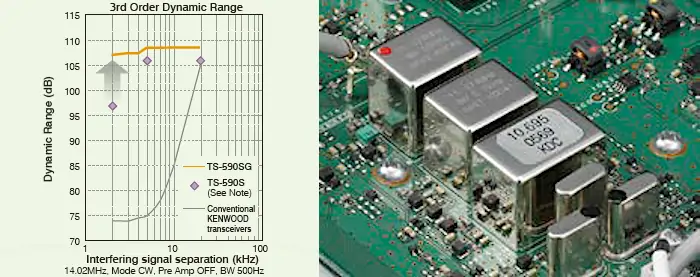
Kenwood TS590S / TS590SG dynamic range comparison (left) and TS590SG roofing filter photo (right)
It can be seen that the TS-590SG achieves virtually flat characteristics even in the 3rd Order Dynamic Range measurement method implemented by ARRL. Note, TS-590S measurement values from QST magazine (May 2011) product review published by American Radio Relay League.
TS-590SG DDS synthesizer :
Superior adjacent C/N with DDS. This is a method in which, for the 1st local oscillator, instead of employing conventional PLL/VCO, the output of a DDS (Direct Digital Synthesizer) is supplied directly to the Mixer. During down conversion, the oscillation frequency is lower than it is in up conversion, so even better C/N (Carrier to Noise ratio) characteristics can be achieved.
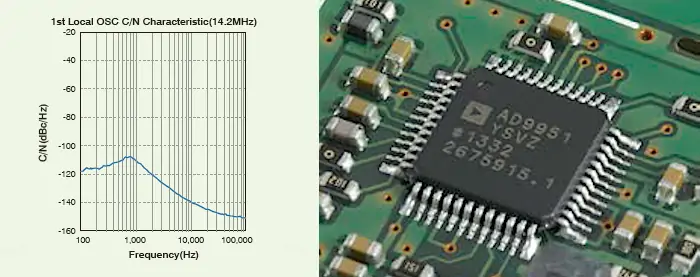
Kenwood TS590SG 1st local oscillator noise characteristics and DDS integrated circuit AD9951
As a result, the characteristics for reciprocal mixing due to the large input signal approaching the reception signal are improved.
TS-590SG advanced AGC :
Advanced AGC control through digital signal processing from the IF stage onward. It would be no exaggeration to say that Kenwood's reception audio, which enjoys a reputation for being non-tiring even in long contests, is determined by IF AGC control based on unique DSP algorithms.

Kenwood TS590SG block diagram, the IF AGC control
This series features all of the IF DSP AGC technology developed with the TS-990S. A remodeling of the AGC circuitry has realized superb AGC performance covering from small to large inputs. Even if interference signals slip between the Roofing Filter and the IF DSP filter that determines the final selection, level optimized AGC control enables operation without the need for awareness of Roofing Filter bandwidth.
TS-590SG adjustable IF filter passband and notch :
Adjustable IF filter passband. This operates as the passband HI CUT/LO CUT function in SSB/AM/FM modes, and as the WIDTH/SHIFT control function in CW/FSK/SSB-DATA modes. Operation can be switched using the menu in SSB and SSB-DATA modes.

Kenwood TS590SG IF Shift/Width and IF auto-notch
IF Notch. Remove a powerful interfering signal with a notch filter to capture a weak target signal. Choose from automatically variable notch frequency in IF Auto-Notch (available in SSB mode) and manually adjustable notch frequency in Manual Notch (available in SSB/CW/FSK modes) depending on your interference situation.
Whereas IF auto notch is effective against a single, powerful beat, the beat cancel feature works well when there are multiple, weak beats. BC1 is effective to remove weak and/or continuous beat interference, while BC2 is effective for intermittent beats like CW signals.
In addition to the analogue noise blanker (NB1), which has a proven track record for eliminating weak noise, this transceiver is equipped with a digital noise blanker (NB2). The optimum blanker for the type of noise and reception conditions can be selected. NB1 enables stable noise suppression independent of reception bandwidth, while NB2 is effective against noise that defies tracking by an analogue noise blanker.
TS-590SG digital noise reduction :
This radio features two kinds of noise reduction methods, NR1 and NR2. NR1 applies the most optimum kind of noise reduction for each reception mode, while NR2 employs the SPAC method, which is more effective for CW operation. NR1, spectral-subtraction noise reduction has been developed with a focus on improving reception clarity for weak SSB signals. It enables the bringing to the surface of a target signal that is swamped by noise, without any loss in sound quality. For non-speech modes (FSK and CW), a line enhancer offers tried and true noise reduction.

Kenwood TS590SG digital noise reduction NR1 (left) and NR2 (right)
NR2, is a SPAC-based noise reduction that is effective for CW operation as it can suppress noise at the same frequency as the target signal. NR2 is not available for FM mode.
TS-590SG reliable design :
A pair of 60 x 60mm fans have been used for the cooling system, which provides sufficient air flow at low rpm for less noise. Attention has been paid not only to the fans and motors but also to the size and shape of the intake/exhaust vents as a comprehensive approach to quieter operation. The aluminum die-cast chassis is combined with a large heat sink to effectively dissipate heat, minimising the rise in temperature in the final section during continuous transmission sessions.
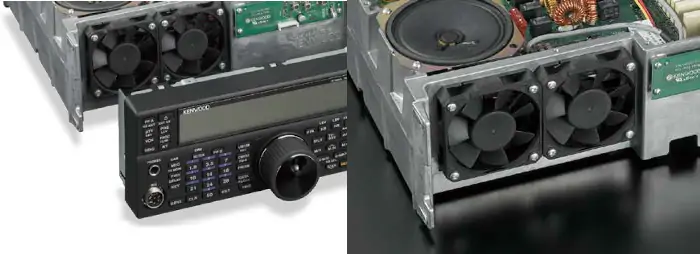
Kenwood TS590SG heavy-duty design
This heavy-duty design is capable of withstanding grueling conditions typical of contests or long hours of hard operation.
TS-590SG built-in automatic antenna tuner :

Kenwood TS590SG built-in high-speed automatic antenna tuner
TS-590SG drive output :
The transceiver comes equipped with a drive output (DRV) connector that enables external access to the transmission drive output (~0dBm). This is not just convenient when a transverter is attached, this DRV connector can also be put to use for transmission on the 135 kHz band, for which the main antenna terminal cannot be used. Performance can be further enhanced when combined with a dedicated reception antenna connector.
TS-590SG TX features :
The speech processor (SSB/AM/FM) increases the clarity of messages for the receiving station by raising average transmission modulation. Besides adjusting compression level, soft and hard modes are available for 2-level adjustment. Compression levels can be set for each of mic transmission and voice-message transmission. The TX filter passband (SSB/AM) is also switchable. Low-pass and high-pass cut-offs can be switched independently for fine control over filter operation. The equaliser (all voice modes) enables the adjustment of frequency characteristics to suit the voice quality and microphone characteristics on the transmitting end. Users can choose from flat (default), high boost (2 types), formant pass, and bass boost (2 types), as well as conventional and user settings (using the ARCP-590G).
TS-590SG CW features :
Morse code decoder function, received morse code displayable by scrolling on 13-segment display unit. Characters are shown in a dedicated window on the ARCP-590. CW auto-tune, you can automatically zero-in on a target signal during reception in CW operation with just the press of a button. This function will also tune in to the RIT frequency during RIT operation. An built-in electronic keyer paddle terminal and a separate terminal for an external keyer have been included. PC keying is possible even when a paddle is connected. Support for full break-in and semi break-in with delay time 50~1000ms.
TS-590SG remote control :
Using the ARCP-590G radio control program (available free for downloading from the Kenwood website), virtually all functions can be controlled via a computer. Changing various function settings and managing memory channels can all be done from your PC. The ARCP-590G also enables the recording and erasure of voice messages.
TS-590SG rear panel and connections :

Kenwood TS590SG rear panel and connections
TS-590SG options :

Kenwood TS590SG options (software available free for downloading)
TS-590SG price
We have collected for your convenience the Kenwood TS-590 sale price (US Dollar) and its trend over time. Useful to guarantee a cheaper purchase of this radio and to put it for sale in the second-hand market. Of course offers, accessories, warranty terms and conditions can lead to different figures.
|
|
|
|
| USD 1899.95 | 2023-mar | Brand-new |
|
USD 1895.00 (1610EUR) |
2021-oct | Brand-new |
|
USD 1853.00 (1590EUR) |
2020-aug | Brand-new |
| USD 1369.95 | 2020-aug |
Brand-new Store special offer |
TS-590SG review
Your opinion on merits, defects, experiences, with this radio set is welcome. Write your review, after a technical evaluation by our staff if found suitable will be published on this page. We thank you for your precious contribution.
